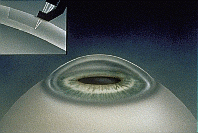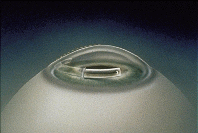|
contact us
| |
INTACS
 INTACS
(Intrastromal Corneal Ring Segments) are the first FDA
approved option for correcting mild myopia
(nearsightedness) that does not require a laser.
They are approved for treatment of -1.0 to -3.0 diopters of myopia with no more than 1 diopter of
astigmatism. Patients must be 21 years of age or
older for this procedure. INTACS
(Intrastromal Corneal Ring Segments) are the first FDA
approved option for correcting mild myopia
(nearsightedness) that does not require a laser.
They are approved for treatment of -1.0 to -3.0 diopters of myopia with no more than 1 diopter of
astigmatism. Patients must be 21 years of age or
older for this procedure.
As shown
above, INTACS are two tiny acrylic half rings that are
permanently placed in the periphery of the cornea. INTACS are made in different
thick nesses which determine the
amount of flattening of the peripheral cornea. This
flattening is what corrects the vision.
The INTACS Procedure
 |
The procedure takes about 15
minutes. The patient is given drops that
numb the eye. Then a tiny opening is made
on the edge of the cornea underneath the eyelid. |
 |
After the opening is made, two
tunnels are created in the periphery of the
cornea. |
 |
The INTACS are then placed in
these tunnels which are between the layers of
tissue in the cornea. |
 |
INTACS reshape the cornea without
disturbing the visual axis and they are usually
placed in the eye permanently, but can be removed
if needed. Inside the cornea, they are
practically invisible and they cannot be felt. |
Advantages/Disadvantages
of INTACS
The
main advantage of INTACS over LASIK is that the
normal corneal architecture is left unchanged and
the quality of vision with Intacs is quite good.
Also, if for any reason, the patient or doctor
wish to remove the segments, this can be done as
another outpatient procedure. The eye usually
returns to its usual amount of nearsightedness
after removal.
The
main disadvantage to INTACS is that they only are
approved for mild amounts of myopia and in
patients with no or little astigmatism. The
procedure is slightly more irritating than LASIK
and visual stability can take from several days
to several weeks. Also, there is a higher
probability of post-operative glare after INTACS as compared to
LASIK. Your doctor can help you
determine which procedure is right for you.
More
recently, INTACS have been used in keratoconus patients. The procedure for
keratoconus is similar to the traditional INTACS
procedure for low myopia. However, in keratoconus
procedures, the placement incisions are made laterally
for inferior and superior segment insertion. In addition,
the thickness of the ring segments may vary in accordance
with the greater amount of corneal flattening required in
the keratoconic cornea. for a large photo of INTACS placement for keratoconus
(you will note that the ring segments in the photo are
placed superior ally and inferior ally - in a non-keratoconus patient, these segments would be placed
laterally).
|